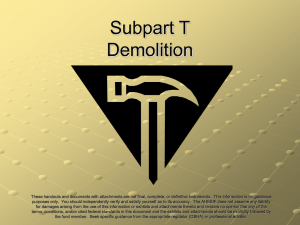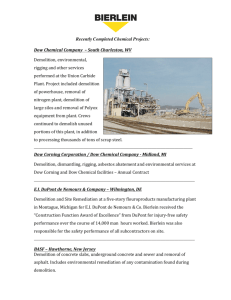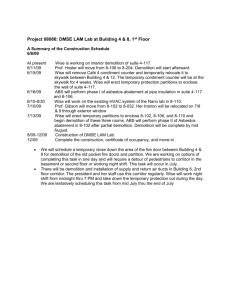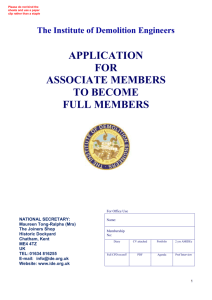case study: demolition practice of old mara building on lot 1767, lot
advertisement
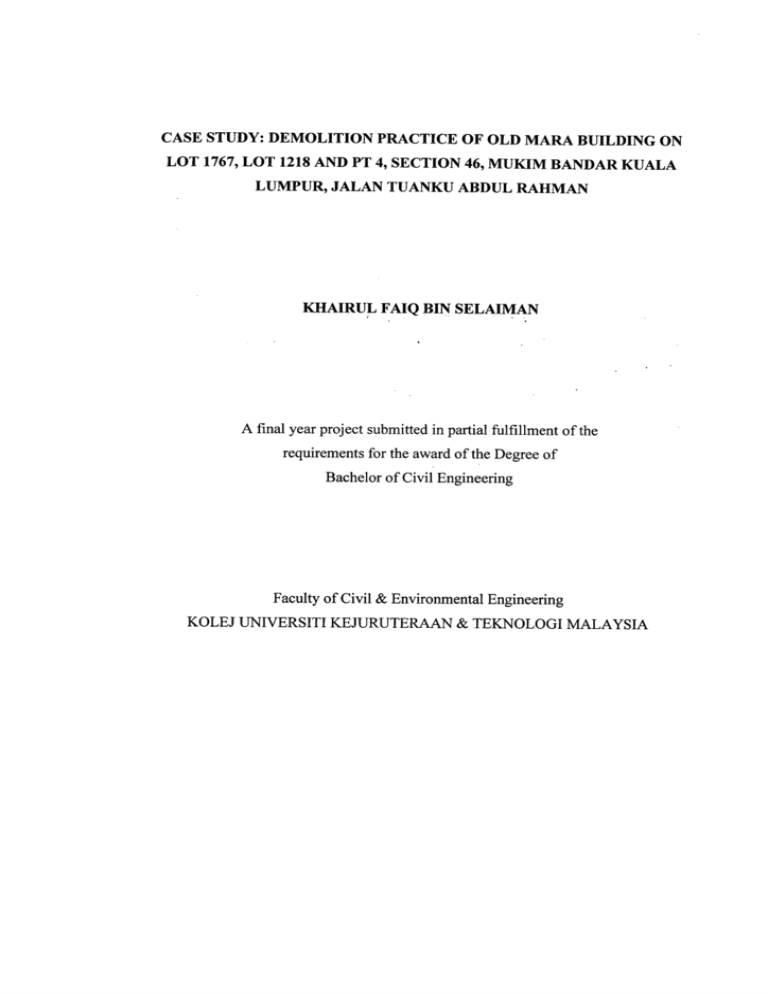
CASE STUDY: DEMOLITION PRACTICE OF OLD MARA BUILDING ON LOT 1767, LOT 1218 AND PT 4, SECTION 46, MUKIM BANDAR KUALA LUMPUR, JALAN TUANKU ABDUL RAHMAN KHAIRUL FAIQ BIN SELAIMAN A final year project submitted in partial fulfillment of the requirements for the award of the Degree of Bachelor of Civil Engineering Faculty of Civil & Environmental Engineering KOLEJ UNIVERSITI KEJURUTERAAN & TEKNOLOGI MALAYSIA VA ABSTRACT Nowadays, there are various types of procedure- or provision issued by many institutions and departments all over the world such as British Standard Institution, Occupational Safety and Health Act, Department of Environment, etc. in order to provide the guideline for good practice and guidance in demolition works. The research contains basic information of procedures, process, techniques and demolition methods, legislative requirement and example of demolition project in this country. It also includes the latest requirement for practitioners on better planning and helps them to select the most suitable demolition method. This research should be used in conjunction with Verified Regulations to develop the work plan for approval by Public Work Department (JKR), Local Authority etc. This study also proposed the procedure on how the:work plan is developed. . It is essential to produce the work- plan to ensure a systematic and consistent decision can be produced before execution. Beside, a study about demolition work of old MARA building on Lot 1767, Lot 1218 and PT4, section 46, Kuala Lumpur, Jalan Tuanku Abdul Raliman had been conducted to be a guideline in the process of work planning also as an example of legislative requirement needed by local authorities of this country and helping in verification process. vi ABSTRAK 41 t Pada masa kini, terdapat pelbagai prosedur dan peraturan yang dihasilkan oleh pelbagai institusi dan jabatan di seluruh dunia seperti British Standard Institution, Jabatan Alam Sekitar dsb. bagi memberi panduan dan garis pandu tentang kaedah perobohan. Kajian mi merangkumi makiumat asas tentang prosedur, proses, teknik dan kaedah perobohan, peraturan serta contoh projek merobohkan bangunan yang terdapat di negara ini. Kajian mi juga merangkumi keperluan terbaru untuk perancangan yang lebih baik bagi membantu pihak yang terlibat memilih kaedah yang paling sesuai untuk projek perobohan. Kajian mi perlu diteliti dan disesuaikan dengan peraturan yang sah untuk membangunkan rangka kerja bagi mendapat kelulusan dari Jabatan Kerja Raya (JKR), Pihak Berkuasa Tempatan dsb. Kajian mi turut mengusulkan panduan bagaimana rangkã kerja dibangunkan. Adalah penting untuk menghasilkan rangka kerja bagi memastikan keputusan untuk memilih teknik yang sesuai adalah konsisten dan sistematik sebelum perlaksanaan.Selain itu, satu kajian tentang projek perobohan telah dijalankan iaitu di bangunan MARA lama di Lot 1767, Lot 1218 dan PT4 seksyen 46, Jalan Tuanku Rahman, Kuala Lumpur sebagai panduan bagi membantu proses pembangunan rangka kerja clan juga sebagai contoh keperluan undang-undang yang digariskan oleh Pihak Berkuasa Tempatan di negara mi dan membantu dalam proses untuk mendapat kelulusan sebelum perlaksanaan bagi sesuatu projek perobohan. vii TABLE OF CONTENTS CHAPTER TITLE PAGE DECLARATION DEDICATION ACKNOWLEDGEMENT iv ABSTRACT v ABSTRAK vi TABLE OF CONTENTS vii LIST OF TABLES xi LIST. OF FIGURES xii LIST OF APPENDICES xiii INTRODUCTION 2 1.1 Introduction 1 1.2 Problem Statement 2 1.3 Objectives 2 1.4 Scope of Study 3 1.5 Methodology 3 1.6 Expectation 4 LITERATURE REVIEW 2.1 Introduction 5 2.2 Techniques for Structure Demolition 6 2.21 Progressive Demolition 6 vi" 2.3 2.4 2.5 2.2.2 Mechanism of Control Demolition 6 2.2.3 Deconstruction or Top Down 7 Demolition Methods 7 2.3.1 Hand Demolition Method 8 2.3.2 Heavy Machinery Razing Operation 8 2.3.3 Explosion Method 10 2.3.4 Pressure Bursting Method 11 2.3.5 Dismantling Method 12 2.3.6 Mechanical Demolition Method 14 Demolition Process and Procedures 15 2.4.1 Pre -Demolition Process and Procedures 16 2.4.2 Actual-Demolition Process and Procedures 20 2.4.3 Post-Demolition Process and Procedures 21 Precaution Measurement 22 2.5.1 23 Covered walkway, hoarding and catch platform 2.5.2 Temporary Support 24 2.5.3 Scaffolds, working platforms, screens 26 and catch fans 3 2.5.4 Existing utilities 26 2.5.5 Debris and waste handling 26 2.5.6 Special site safety 27 2.5.7 Maintenance and inspection 29 2.5.8 Emergency Plan 29 2.5.9 Post Demolition 30 RESEARCH METHODOLOGY 3.1 Introduction 31 3.2 Resources and References 31 3.3 Studies by Process Sequence 32 3.3.1 33 Identify ix 4 3.3.2 Justify 33 3.3.3 Conclusion and Suggestion 34 CASE STUDY; DEMOLITION OF OLD MARA BUILDING, KUALA LUMPUR 5 4.1 Introduction 36 4.2 Project Background and Details 37 4.2.1 37 Contract details 4.3 Safety Measure 38 4.4 Demolition Method 39 4.5 Demolition Process 39 4.6 Demolition Sequences and Procedures 42 4.6.1 Cantilevered Canopies and Balconies 42 4.6.2 Exterior Walls, Beams and Columns 43 4.6.3 Floor Slabs 45 4.6.4 Interior Beams and Columns 45 CONCLUSION AND SUGGESTION 5.1 Introduction 46 5.2 Objective Assessment 47 5.2.1 Objective One: Study about demolition 47 process and procedures 5.2.2 Objective Two: The criteria involve in 47 method and technique selection 5.3 REFERENCES APPENDIX A APPENDIX B Suggestion 49 52 x LIST OF TABLES TABLE NO. TITLE 2.1 Width of Covered Walkway 23 2.2 Design Criteria for Covered Walkway and Catch Platform 23 2.3 Minimum Specification for Polyethylene Net 24 2.4 Propping Requirements on the Operation of Mechanical 26 Plant on Suspended Floor PAGE xi LIST OF FIGURES FIGURE NO. TITLE 2.1 Criteria for Hoarding and Covered Walkway 25 3.1 Flowchart of Research Methodology 35 4.1 Scaffold Installation 38 4.2 Screen and Net Installation 38 4.3 Lifting up the Machinery 39 4.4 Moving the Machinery by Means of Ramp 40 4.5 Demolition Works from Inside 41 4.6 Demolition Works from Outside 41 5.1 Flowchart of Work Plan Flow Process 50 PAGE xli LIST OF APPENDICES APPENDIX TITLE APPENDIX A Procedures Specification Checklist 53 APPENDIX B General Criteria of Demolition Method Selection 59 PAGE CHAPTER 1 INTRODUCTION 1.1 Introduction In general, demolition can be defined as wrecking or taking out of any loadsupporting structural element of a building (houses, commercial establishments, and office buildings) or non-building facility (highways, streets, and other non-inhabitable construction projects). The era of demolition is begun centuries ago. Nowadays, this industry brings a lot of potentials and become highly sophisticated business and also requiring expertise and competent persons. Demolition and construction, two major types of building and structural industry definitely opposite against each other in many conditions and have a lot of different. "It's a popular misconception that demolition is nothing more than knocking down a structure and hauling the debris to a landfill. That assumption is wrong on many counts, especially: First, the process of planning for and completing a demolition project is far more thorough and complex than simple knockdown. Second, demolition contractors are master of recovering valuable materials and minimizing need for disposal. Almost of the structure is salvaged for reuse and recycling then make the cost saved and bring more profit for the owner."(NADC, 1999) Demolition is very high risk job, complex and unique required well knowledge and strict regulation and precaution measurement that must be followed to avoid any damage to human life and environment. Z 1.2 Problem Statement In Malaysia, the scenario of demolition industry have enhanced due to the demolition project that had been take place to provide new building arise from a same site. The demolition techniques that selected by professional engineer is just based on their knowledge and experienced. Apparently, there are no particular procedure were followed by them to support their current decision making process. As addition, there are many ways to demolish the old structure to construct the new one. Then, it comes very tough to select the best technique in this industry and at the same time concern about the risk that must be taken. Demolition process for building structure is unique because there are many important parameters and criteria that must be concern. As a result, critical selections happen and make it difficult to the engineer to decide the 'right and the best technique to be adapted in this industry. Hopefully by this study, an adoptable conclusion about demolition practice in this country can be determined, therefore an effective demolition technique and method can systematically decided. 1.3 Objectives The main purpose of this study is to emphasize the important of demolition study in helping professional engineer and experience-based insight to governmental decision makers, building and site owners, developers, contractors, and others who are responsible to choose an appropriate demolition methods and techniques to be adapted. The objectives of the project are to: i. Identify the demolition process and procedures. ii. Justify the criteria involve in method and technique selection. 1.4 Scope of Study In order to fulfill the objectives that had been stated before, the scope of study must be carefully determined This study is intended to cover process and procedures involve in demolition practice for general building and common civil engineering structures only, and not including major of civil engineering works such as excavation, and it is not applicable to unauthorized building works such as highway, bridges, dams etc. The characteristics for various demolition methods will be defined by knowledge acquisition. For the purpose of this study major resources are adapted from verified provision and regulation which are Code of Practice for Demolition of Building BS 6187, 2000 by British Standard Institution and also from Hong Kong Building Department. Meanwhile, the criteria involve in method and technique selection will be determined by literature review and also by case study. The demolition project that had been chosen as a case and example of demolition practice is MARA office building, Kuala Lumpur. It is essential to be conducted to ensure the study is adaptable to use in conjunction with legislative requirement of this country and ensure the objectives are accomplished. 1.5 Methodology The topic is selected based on the problem statement that had been stated before. After the root problem occurs in demolition practice is defined, literature review will be conducted. All information and data will be gathered and organized to ease the flow of research conduction. Verified regulation will be used as a raw material and resources and it will be reorganized in literature review. Demolition contains huge of consideration, otherwise the definite scope and specification of the research is measured. As stated before, this study is intended to cover common civil engineering structures and general building only. 'I Generally, demolition for high building is easily found in busy urban area of this country. Therefore, Kuala Lumpur is the exact location that selected for this research. In order to fulfill the expectation and objectives as stated before, case study had been conducted in collaboration with Majlis Amanah Rakyat (MARA), Malaysia. The demolition project is located in Kuala Lumpur near Jalan Tuanku Abdul Rahman. It is intended to give a real view of demolition scenario in this country and also provides an example of legislative requirements needed in this country. Finally, all data will be gathered and will be analyzed based on literature review and case study that had been conducted. At the end of this study, objective assessment will be measured and final conclusion and suggestion will be discussed to ensure the entire objectives that had been listed are accomplished. Chapter 3 outlines details of research methodology for further information. 1.6 Expectation The study will give a specific information and knowledge about demolition practice and its potential in this country. A solution about a consistent and appropriate way to adapt while choosing the techniques can be determined. Hopefully, it will be used as a guideline to the practitioners in ordr to decide a systematic and consistent decision of method for demolition. However, the aim of this study is not to be another practice guard or regulation but to identify the process and procedures involve in demolition practice and also the criteria involves in technique and method selection. CHAPTER 2 LITERATURE REVIEW 2.1 Introduction This part is intended to determine types of technique for structure demolition that usually practiced in commercial demolition industry. This part features methods of demolition that involve in the demolition practiced. It outlines good practices of each type of demolition methods and will helping in identifying the criteria to develop the best solution on work plan development base on the job principles, structures applicability, efficiency, pollution characteristics, etc. This part sets out the guidelines for demolition process from the initiating and planning to the implementation and completion of building demolition based on the procedures matters. This part is intended to give basic precautionary measures and safety actions at the work place/site to avoid damages and effects to human life, environment, and the adjacent properties. For the purposes of this chapter, the major of precautionary measures and procedures are adapted from Code of Practice for Demolition of Buildings, Hong Kong Building Department, (BD) 2004 regulation. Besides, this part also features other regulations such as BS 6187, 2000 Code of Practice for Demolition by British Standard Institution and additional precise references and resources. to 2.2 Techniques for Structure Demolition According to British Standard Code of Practice for Demolition, BS 6187, there are three types of structure demolition. i.ProgressiVe Demolition ii.Mechanism of Control Demolition iii.DeconstrUction or Top Down 2.2.1 Progressive Demolition Progressive demolition is a technique to demolish, wrecking or taking out of any load-supporting structural member part by part before the building completely fall (fully or partially demolish) at the same time considered the structure stability so the building will not collapse simultaneously (BS 6187, 2000). It is commonly adapted to high rate of catch area and commonly practices using heavy machinery and equipments. The heavy machinery or equipment includes large motorized vehicles such as bulldozers with rakes, backhoes, hydraulic excavators, and other similar machinery used for transporting, moving of materials at a demolition site. Cranes equipped with wrecking balls, clamshells, or buckets are also considered heavy machinery. 2.2.2 Mechanism of Control Demolition Control demolition is a technique to demolish, wrecking or taking out of the main structural member or element before the building completely fall, fully or partially demolish. (BS 6187, 2000) Equal to progressive demolition; it is commonly adapted to 7 big catch area condition and usually practiced using explosion/implosion and wire rope pulling methods or any other suitable method. 2.2.3 Deconstruction or Top Down Deconstruction or Top down method is the technique that proceeds from the roof to ground in a general trend, there are particular sequences of demolition which may vary, depending on site conditions and structural elements to be demolished. (Hong Kong, BD Code of Practice, 2004),It is the process of dismantling a building in order to salvage the structural members for material reuse and recovery and commonly practices by machinery and hand demolition methods, lop down method is applicable for most sites, particularly for those situated in busy urban areas. 2.3 Demolition Methods Generally, there are several types of demolition methods that usually used in demolition practices all over the world. The selection of demolition method concern about project and site condition, public safety and sensitivity, availability of tools and equipments and many others requirement and regulations that must be followed. The complex situation in the demolition site demands specialized skill, well knowledge and also expertise from the people that involved in this industry. In this part, a comprehensive review and study will be done to give a better understanding and information. The demolition methods that usually adapted in demolition process are; i. Hand Demolition Method ii. Heavy Machinery Razing Operation a. Pneumatic and Hydraulic Machinery 0 b. Demolition using rig-mounted breakers c. Demolition using rig-mounted crushers iii. Explosion Method iv. Pressure Bursting Method v. Dismantling Method a. Thermal Lance b. Water Jet c. Dismantling by Sawing and Drilling d. Dismantling by Cutting and Lifting vi. Mechanical Demolition 2.3.1 Hand Demolition Method This type of method usually practiced for small demolition volumes (.g. house, single storey building, etc). A building will be demolished from the super structure to the structure below. It is strictly opposite with the construction works that begin from the ground and this method also have the particular sequenced that must be followed. The best technique that can describe this method is known as deconstruction or top down. It is highly labor intensive, slow and expensive. This method is only used when the other method is not suitable depends on the availability of the equipments and tools and usually practiced as alternative method. 2.3.2 Heavy Machinery Razing Operation For the purpose of this research, heavy machinery can be determined as heavy motorized vehicle used for breaking, crushing, moving, and wrecking all the materials from the demolition site. Razing operation is the process to reduce building structural segments to rubble or small sections and then move it onto the ground. Usually this method is used when hand demolition method is not capable or not suitable to be practiced. i. Pneumatic and Hydraulic Machinery Often used in concrete demolition projects involving bridge decks, foundations and pavement, pneumatic and hydraulic machinery are currently the tool of choice. The volume of work accomplished using these methods depends on the hammer size, strength of the concrete, the amount of steel reinforcing used in the concrete, and working conditions. ii. Demolition using rig-mounted breakers Pneumatic and hydraulic breakers are available for attach different types of carriers. This method gives the great advantage and impact much more power compared to hand demolition method. "Hydraulic breakers demand the use of carriers with sufficient stability (weight ratio)."(Brokk AB, 2000) Better precaution is needed while handling the carrier because the operator or conductor is exposed to the hazard and crucial factor especially when to demolish the sideways. Good handling of the carrier is important to avoid injury if the structures collapse. iii. Demolition using rig-mounted crushers The manual operation of this method did not have much different compared to the rig-mounted breakers. The different between two of this machinery is the noise level that will be carried out. While conducting this machinery, the main noise that will be produced is just the sound of the material being crushed and of debris falling. First, grip the material then crushed it. It is simple to handle but needed a competent operator to do this job. "Compared with using a rigmounted breaker this method often makes it possible to have much longer 'U working shifts per day when conditions and restrictions limit the length of time a breaker can be used." (Brokk AB, 2000) 2.3.3 Explosion MethOd Explosion method is a versatile and high risk method that practiced in a demolition industry since centuries ago. This method conducts by explosive material usage and strategically placed at the certain member of structure so that the structure will collapse by itself. The safety factor and precaution measurement are the main factor that will involve in this method beside any regulation to avoid failure in demolition process that causes surrounded dangerous and risks especially public safety and anxiety. This method demands expertise and specialist demolition engineer and blaster. According to Construction Planning, Equipment, and, Methods Sixth Edition, there are four main categories of commercial high explosives 1) dynamite, 2) slurries, 3) ANFO, and 4) two-component explosives. To be a high explosive, the. material must be cap sensitive, react at a speed faster than the speed of sound, and the reaction must be accompanied by a shock waves. i. Dynamite The main material in this type of explosive is Nitroglycerin. This Nitroglycerinbased product (Straight dynamite) is the most sensitive explosive method compared to other products. Straight dynamite is not appropriate for demolition applications because it is anti-shock product. The most suitable used product is known' as 'high-density extra dynamite' products which are have their own trade names by individual explosive manufacturers. It is very low sensitivity to shock and some of the Nitroglycerin has been replaced with ammonium-nitrate. I ii. Slurries This is a generic term for both water gels and emulsions. Water gels are water resistant explosive mixtures of oxidizing salts, fuels, and sensitizers. The advantage of slurries than dynamite is that the separate ingredients can be hauled to the project in bulk and mixed immediately before loading the blast-holes. iii. ANFO It is an ammonium nitrate and fuel oil mixture, also known as dry blasting agents. It is the cheapest source of explosive energy and much safer compare to dynamite usage. But, it demands complex procedure of fuel condition. The mixture also free flowing and it is not water resistant. iv.Two-Component Explosive Two-component or binary explosives are not classified as an explosive until combined. Therefore, they offer advantages in transportation and storage and an alternative method for small demolition jobs but expensive compared to other products. 2.3.4 Pressure Bursting Method This method can be divided into mechanical and chemical bursting procedure. Pressure bursting can be used in case which low noise, dust-free, controlled demolition is preferred. Both of them split the concrete. For the mechanical bursting, a splitting machine operating on hydraulic pressure provided by a motor is used and in the case of chemical bursting, the expansive slurry will insert into a pre-determined pattern of boreholes. At the post-demolition process, the debris and waste easily to handle and manage. 12 "Hydraulic and chemical pressure bursting break up concrete structures with a minimum of noise and flying debris. Both methods work by applying lateral forces against the inside of holes drilled into the concrete, and can do virtually any job other demolition methods are capable of. However, rather than shattering the concrete into bits as dynamite and impact tools would, the lateral forces build up over time to crack the concrete into smaller sections."(Liss, 2000) Non Explosive Demolition Agent (NEDA) is a best example to describe pressure bursting by chemical reaction. According to Hong Kong, BD Code of Practice 2004, NEDA is a static agent that generates an expansive pressure to crack/break/split concrete and stone. The loading intensity and water content shall be controlled to optimize the expansive pressure and prevent blow-out of the NEDA. The effect of this agent is smaller compare to explosion method. 2.3.5 Dismantling Method This procedure divides into four main types which are thermal lance, water jet, demolition practiced by sawing and drilling and also cutting and lifting. It is practice by cutting concrete elements, and then removing them by crane or other machinery usage. The demolition of an entire concrete structure may be carried out with a minimum of noise, dust, and impact on surrounding structures. i. Thermal Lance According to Hong Kong, BD Code of Practice 2004, this method demands high precautionary measure because it involves very high heat up to 2000 °C-4000 °C. The use of a thermal lance in cutting reinforced concrete shall not be used unless the project demonstrated that there is no other viable alternative; adequate protective measures are provided to isolate the operation and to prevent any potential fire spreading out; and adequate protective measures are provided to prevent the injury of the workers, by flame and the molten concrete. 13 ii. Water Jet Water jetting is a method to minimizing dust and eliminating the dust and free from fire hazard. It involves the use of high pressure of water jet pumped to clean out the aggregated and erode the cement matrix. Reinforcing steel can be cut by mix the abrasive compound with water. As a precaution, all peoples that involve in site shall wear appropriate clothing and cover outfit. iii. Dismantling by Sawing and Drilling Dismantling process by sawing and drilling method provide accuracy and develop very low of noise. Usually used by combining with other methods, either as preparation of area clearing or total removal of structural sections. According to Hong Kong, BD Code of Practice 2004, it can be used to cut concrete slbs and wall elements into segments. An entire building may be dismantled by saw cutting. Saw cutting generally includes conventional disc saw and chain saw, diamond core stitch drilling and wire saw. a. Wire Saw Cutting Wire saw cutting contain a special steel wire often combined with diamond beads to increase its cutting ability. It is suitable for control demolition technique. A hole shall first be pre-drilled for the passage of the diamond wire, and then follow by the wire cutting operation. Because of its flexibility, it may be used for "hard to reach" areas. A diamond wire saw may also be applied in cutting off piling of marine structures and bridges. b. Diamond Core Stitch Drilling Diamond core stitch drilling may be adopted to cut concrete elements by continuously coring a set of holes to carve up the concrete structure. The thickness of the concrete to be cut depends on the depth of the drilling or coring equipment. Diamond core stitch drilling is particularly suitable in the removal of existing pile cap for construction of large diameter bored pile foundation. 14 iv. Dismantling by Cutting and Lifting Procedures of dismantling involve two main works sequence which are cutting and then lifting. Cutting process means to dismantle the structures and segments into small pieces. For the purpose of this study, cutting process means to dismantle the structures and segments into small pieces using other methods that not included in sawing and drilling procedures such as wire rope usage and other suitable tools. Lifting process means to remove all the materials from the cutting process onto the ground for further demolition and disposal. "Slabs can be cut into segments and then lifted off for further cutting into smaller pieces before disposal. Precast concrete structures can be cut into pieces and then lifted off as a reversal of the construction sequence when the precast elements are fabricated from pieces into an assembly of structure. Cutting and lifting may be applied to safely remove projections such as canopies, architectural features, balconies and bay windows." (Hong Kong, BD Code of Practice 2004) 2.3.6 Mechanical Demolition Method Mechanical demolition can be describe as demolition method that involves the use of heavy machinery combine with other attachment tools to demolish the building from outside and shall be applied only for the building on the flat ground. For the purpose of this study, mechanical demolition methods include pusher arm, wire rope and clam shell usage will be discussed. i.Mechanical Method by Pusher Arm The process involves in this type of method named as pull-in and pull-out procedure. "Mechanical pusher arm involves the use of machines equipped with pusher arm attachment for applying horizontal thrust to demolish the structural element." (Hong Kong, BD Code of Practice, 2004). The special conditions for 15 this method include building condition, tools condition, machine capability and safety distance. ii.Mechanical Method by Wire Rope Pulling "Mechanical demolition by wire rope pulling generally involves the use of an earth mover machine or mechanical winch device equipped with heavy steel wire for pulling down structural members."(Hong Kong, BD Code of Practice, 2004) Various condition must be followed by the people involves such as safety distance, machine capability, structure condition and the strength of wire rope. iii.Mechanical Method by Clam Shell "Demolition by clam shell typically involves the use of crane equipped with a clam shell attachment which progressively bites away the structure" (Hong Kong, BD Code of Practice, 2004).The conditions for this method include safety distance, building condition, the right technique and precaution measurement. 2.4 Demolition Process and Procedures In achievement of good work planning, an adequate procedure of demolition process needs to be determined. Therefore, all personnel and persons involve in the demolition industry must have well knowledge about the process and the demolition procedures. Demolition process covers all the processes from the initial till the end of the project. For the purpose of this study, demolition process divides into three main sequences; pre-demolition, actual-demolition and post-demolition process. Pre-demolition process covers the jobs that need to be done such as planning, hazardous material removal and others before the actual process started. Actual demolition means the process that need to be done during the real of demolition level at


